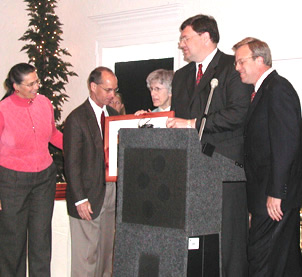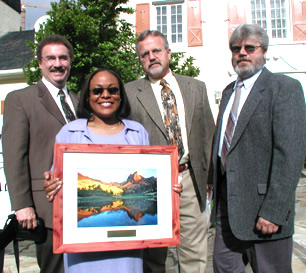2005 Governor’s Quality Growth Awards
(Salt Lake City) On May 18, 2005 the Salt Lake City Department of Public Utilities received two Quality Growth Awards at a ceremony held at the Memorial House at Memorial Grove in Salt Lake City.
Utah Quality Growth Commission Award for Critical Land Conservation
Salt Lake City Department of Public Utilities Watershed Land Acquisition Program
|
The Salt Lake City Department of Public Utilities (Public Utilities) provides municipal drinking water to customers within its service area of Salt Lake City and eastern bench of Salt Lake County. Much of this water originates from the Wasatch canyons bordering eastern Salt Lake County. Preserving and protecting watershed lands are recognized as the most effective ways of protecting a public drinking water supply from pollution. Salt Lake City recognized this fact as early as 1887, when the City started buying property in City Creek, at that time the primary source of drinking water for the community. This 118 year old legacy was formalized in the City’s “1988 Watershed Management Plan,” which established a dedicated revenue source for watershed land purchases. The management plan recommended funding for the land purchases from a surcharge on the water bills. This recommendation was made after an extensive public process, including public hearings before the City Council. In 1991, the City Council approved a “Water Rights and Watershed Purchase Fund (Watershed Fund)” financed by a $0.25 surcharge on each water bill.
The land acquisition program is a unique program due to its funding through local water user surcharges. Community participation in the project heightens the awareness of watershed issues and provides each household an interest in the property purchased under the plan. Surveys conducted by Public Utilities have indicated a strong community interest in the protection of the Wasatch Canyons watersheds. A recent Dan Jones survey showed that 99 percent of those surveyed maintained that it is very important to protect the watersheds along the Wasatch Front.
In 1999 after the Watershed Management Plan was updated, the Watershed Fund was bolstered by increasing the surcharge to $0.50 per bill. Over 1,200 acres of prime watershed property have been purchased with revenues generated by the surcharge. At the end of calendar year 2004, a total of $4.9 million has been spent for watershed water rights and land acquisitions.
Currently the City owns 18.6 percent of the watershed lands in the seven Wasatch canyons along the Wasatch Front. This ownership, along with agreements with the Forest Service, provide for the long term protection of the City’s water supply. In this water limited, semi-arid region of the United States, it is prudent public policy to take extraordinary measures to protect the community’s drinking water supply.
Overall the Watershed Fund has been used to purchase 41 parcels of watershed property. Three of the most recent acquisitions demonstrate the value of this program. In 1994, the Watershed Fund provided the revenue necessary to purchase 124.87 acres of property known as the Cutler Property in Parley’s Canyon. The cost of the transaction was $324,272. In 2001, Willow Heights, a 154 acre tract of land in Big Cottonwood was purchased with a combination of a $700,000 grant from the State of Utah’s LeRay McAlister Critical Land Conservation Fund, and $1.3 million from the City’s Watershed Fund. This wooded property contains an aspen grove, a mountain meadow and beaver ponds. It provides prime habitat for many species of wildlife. Willow Heights is covered by a conservation easement with co-enforcement rights held by Utah Open Lands. One of the most recent watershed land purchases is the Bear Trap acquisition of 39.26 acres in Big Cottonwood Canyon for $856,352. All of these highly developable tracts of land are now protected watershed lands. While these properties provide collateral public benefits, the primary purpose of the acquisitions is to protect the quality of the City’s water supply.
Many communities across the United States are coming to the realization that it’s critical to their future to protect their watersheds to ensure the quality of their drinking water. Notable are Tucson, Arizona; Huston, Texas and New York City, New York, that have initiated watershed purchase programs
2005 Award of Merit for Implementation of a Quality Project
Salt Lake City Water Reclamation Co-Generation Project
|
Public Utilities operates a 45 million gallon per day waste water treatment facility located near I-15 at 2300 North, Salt Lake City. The polished secondary treatment facility serves the City’s 180,000 permanent residents in addition to a day-time population that swells to 400,000 with the influx of students, visitors and workers. The treatment facility is regulated by a NPDES permit establishing water quality standards for the water discharged into the environment. A by-product of the treatment process is methane gas. As a result of both commercial and residential growth in Salt Lake City, the amount of methane gas production has increased, providing an opportunity for a fuel source for electrical power generation.
After conducting a study in 1998, to determine the viability of using methane gas to produce electricity for the City’s wastewater treatment plant, Public Utilities decided to move forward with a $3.8 million cogeneration project. This decision was based on multiple factors.
First, Public Utilities had a need to supply a redundant or standby power source for the wastewater treatment plant in order to satisfy federal requirements and meet growing operational needs.
Second, by using methane, a by-product which is naturally produced during the treatment process to run two 700 KW engine generators, up to 60% of the main plant’s electrical energy needs could be satisfied. This would not only save on electrical costs, but would serve as a redundant power source. Other major benefits would also be realized. The heat produced from running the engines could be captured and used as a reliable and less expensive way to heat the facility’s existing anaerobic digestion process. Obsolete and very maintenance-intensive heat exchangers could be replaced with newer, more efficient heat transfer units. Other areas of the facility could be heated as well.
Finally, 450,000 cubic feet of methane gas produced each day would no longer be flared to the atmosphere. The benefit of reducing the quantity of pollutants released into the air was very attractive to Public Utilities. Though the methane was being flared through a high temperature burner, the engine generators would more efficiently utilize the gas, resulting in lower pollution levels.
The new cogeneration facility utilizes cutting edge technology that uses a lean-burn, low-pressure engine operation. The methane is conditioned much more effectively and proves to be a much cleaner fuel source. The new facility is expandable, allowing for a future engine generator as methane gas production increases with the growth of the city. The new cogeneration facility reduces carbon monoxides emissions from 449 pounds per day to 212 pounds per day and PM10 emissions from 12.6 pounds per day to 8.8.
The cogeneration facility has been in operation since late July of 2004. We believe that this project is an excellent example of utilizing a wastewater treatment by-product to effectively and efficiently operate the treatment facility while improving air quality and reducing regional energy demand. We also believe that it will prove to be a key factor in providing cost-effective, reliable service to our customers.

